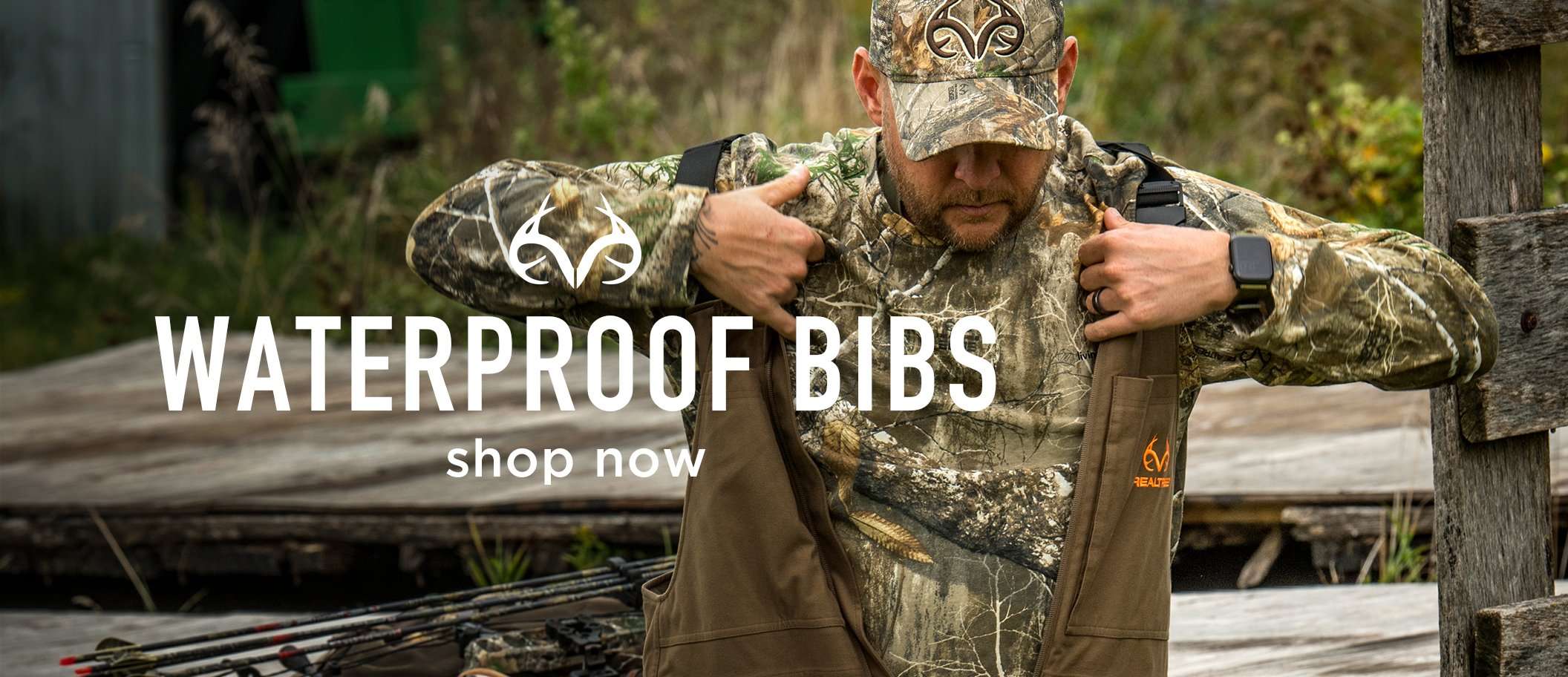Heading out on a beach trip with the family this spring? Pack along your fishing gear and catch some dinner with these handy tips
It’s that time of year. Hundreds of thousands of Midwesterners will pack up the family minivan and head south to seek some salt, sun, and early spring warmth while their home states are still locked in the throes of winter.
The seafood is great, the sun and warm water are nice, and you can even spend a little time in beach gift shops, I guess. But for many, the allure of the beach is the opportunity to catch saltwater fish, something that doesn’t happen often if you live in a landlocked state.

If your family has a trip to the beach planned this year, pack along your fishing gear and hit the surf. Photo by Cheryl Pendley
Sure, you can charter a trip on a boat with a local captain. But that’s also expensive, often hard to get last minute, and subject to weather cancelations. If you haven’t spent much time on a boat in rough seas, you might find yourself spending more of your time hovering over the side of the boat trying to hang on to that morning’s breakfast instead of fishing.
So, try gearing up and hitting the surf instead. You never know what you might catch. Depending on location, it could be a giant redfish, a delicious flounder, pompano, speckled trout, whiting, or even the occasional shark, barracuda, or tarpon.
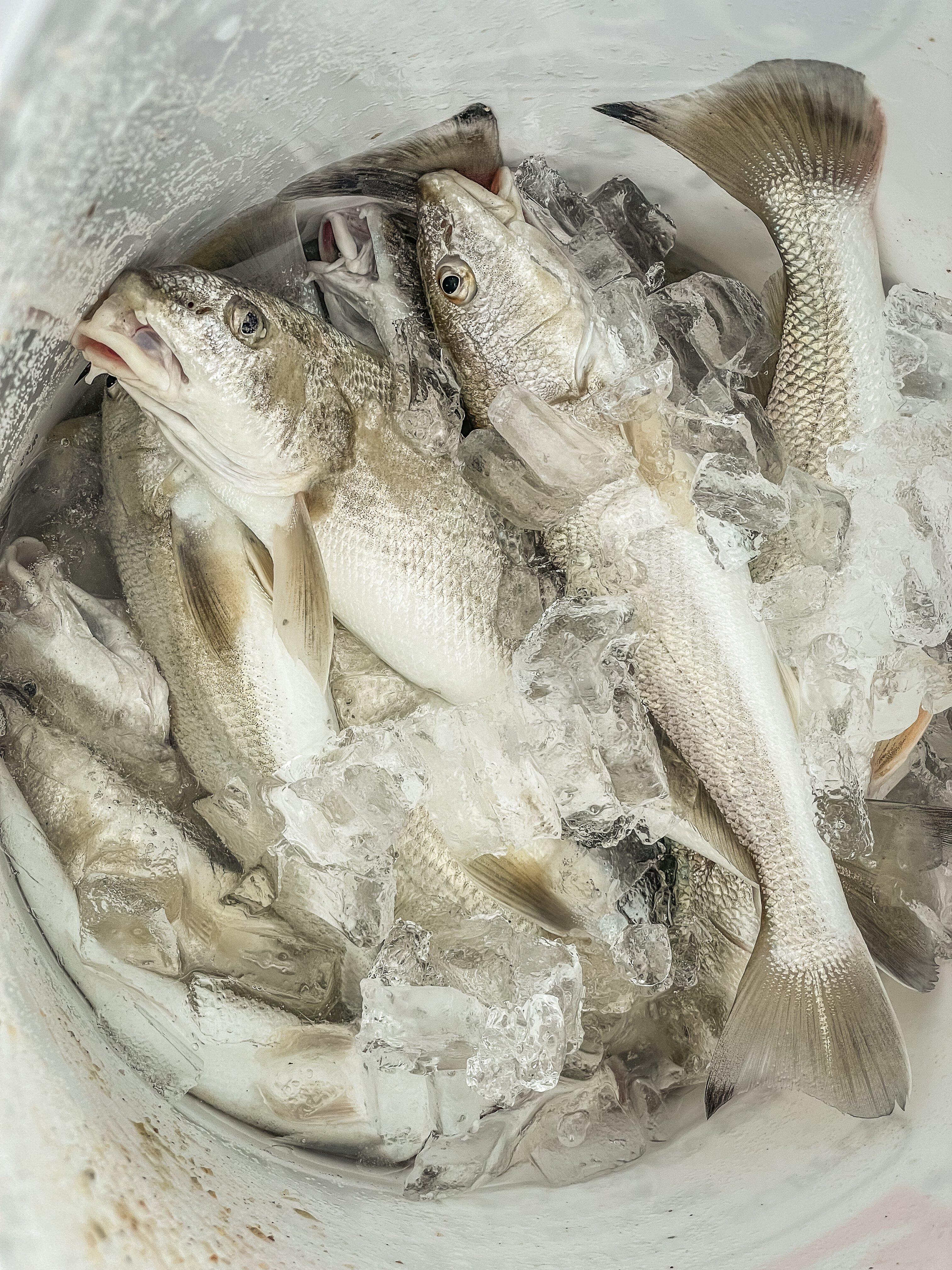
Don’t pass on whiting, salt water’s version of panfish, when the bite for other species is slow. Photo by Michael Pendley
If you grew up fishing freshwater lakes, ponds, and streams, surf fishing might seem a little daunting at first glance. Don’t worry, these tips will have you loading the cooler like a local in no time.
RODS AND REELS
While most of my surf rods are 10 to 12 feet long range for increased casting distance, you don’t have to have specialty gear to catch fish. In fact, the medium-heavy spinning rod and reel you use for bass and catfish will get the job done. Chandler Hatfield works at Fisherman’s Choice Bait and Tackle in Eastpoint, Florida. He recommends a 7’ rod and matching reel spooled with 15-pound test. “That setup will handle just about anything you will catch in the surf around here and be loads of fun while you do it,” he said.
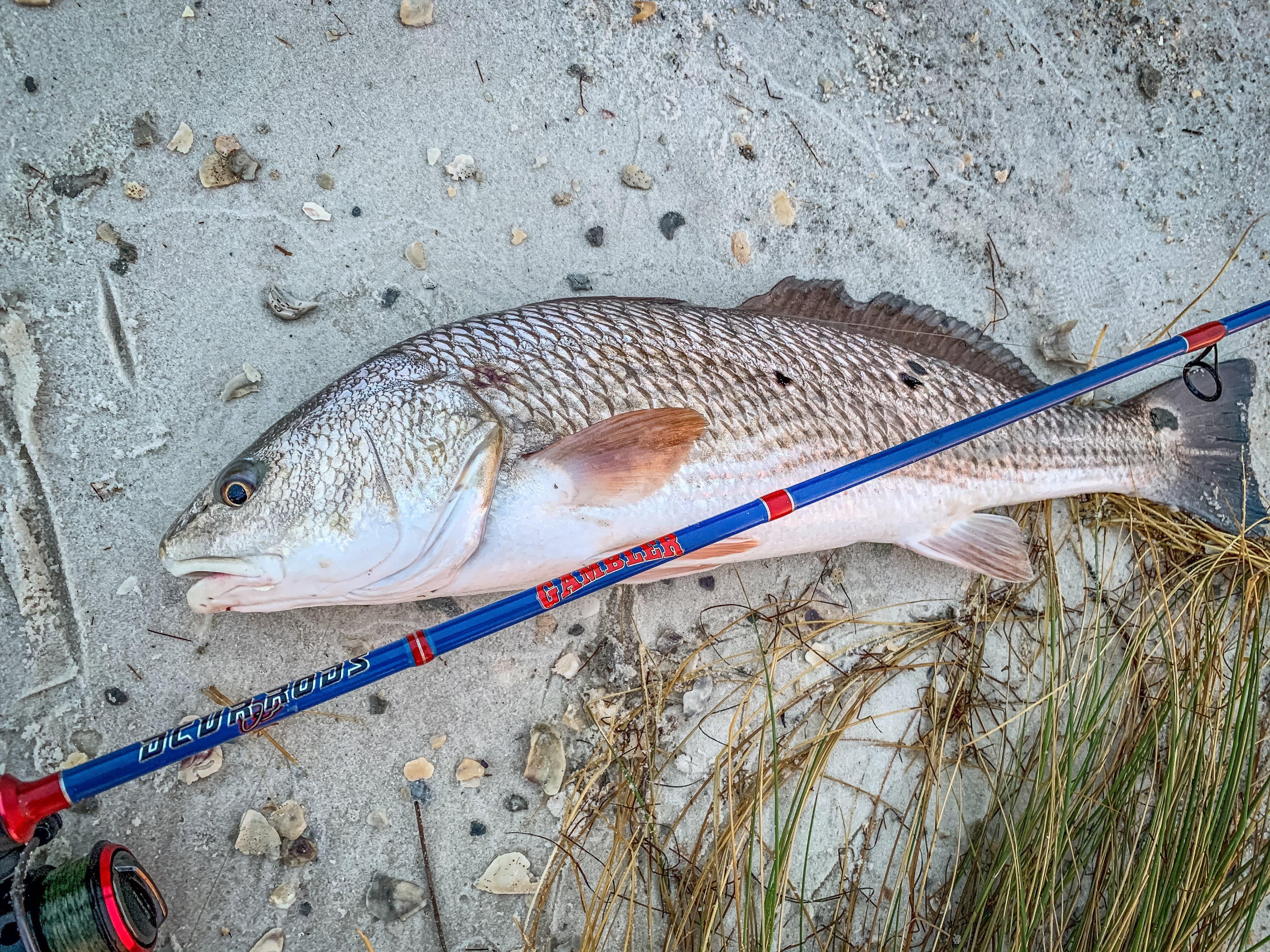
A good medium-heavy bass combo will handle most inshore fishing needs. Photo by Michael Pendley
If you decide to step up, but don’t want to invest in high dollar equipment for a week or two of fishing per year, many local tackle shops offer 10- to 14-foot surf rod-and-reel combos at a lower price point. You can often find them for under $50. While they don’t have the quality of more expensive gear, these combos will do everything you need them to for a short fishing trip or two per year. The added length helps to get your bait out a bit farther when fish aren’t in close and comes in handy when you hook into a large fish.
Josh Norman grew up fishing the Florida Coast before becoming a fisheries biologist for the Florida Fish and Wildlife Commission. He agrees that rod choices come down to where you want to fish. “Most of my fishing is in close, right at break water. You typically catch more fish there, but they will be often be smaller species like whiting or trout. You can catch some pompano, redfish, black drum, or trout if they are running, or by fishing grass flats from shore. For this route, I use an 8-10ft rod with a Penn Battle II 3000.” Norman likes 20- to 30-pound braid on this setup with a monofilament leader.
For deeper water fishing, he steps up his gear size. “Out beyond the sand bars, I’m usually targeting large species like sharks. I typically use a 12- to 14-ft rod with a Penn Battle II 6000 or 8000 size and spool it with 80- to 100-pound braid with a cable leader.”
Whatever gear you use, saltwater conditions and sand will be hard on it. It’s always a good idea to keep reels out of the sand and give everything a freshwater rinse once you are finished for the day.
TERMINAL TACKLE AND BAIT
For live or cut bait fishing, often the most productive on the beach, I typically rig up with a dropper style setup that consists of a 1- to 4-ounce flat or pyramid sinker, depending on surf conditions, at the terminal end and one or two droppers just above the sinker to hold the bait off the bottom. Such rigs are often called pompano or Gulf rigs and will catch just about anything that swims near shore. You can also go with a Carolina style rig just like you would use for freshwater bass fishing, with a sliding sinker above a swivel and a single hook at the terminal end.

A circle hook on a dropper rig will handle most surf fishing live bait needs. Photo by Michael Pendley
As for hooks, I like a No. 1 to No. 4 circle hook for most of my surf fishing. Don’t oversize your hook, since many surf species tend to be on the pickier side and may not fully take a large, exposed hook. Smaller hooks tend to result in better bite to hook-up ratios.
For bait, shrimp is king. Live shrimp can be hooked through the tail or between the horn and the brain. The brain is a dark spot behind the eyes on the shrimp. Avoid running your hook through it if you want to keep the shrimp alive, although there are times when dead shrimp can be just as effective. Norman prefers to peel the shell off the tail and use just the meat on his surf rigs.
A step up in size from shrimp is cut bait. “I like a bloody fish for bait. I typically use cut lady fish or mullet. Any kind of bloody fish will work, but cut lady fish or mullet are the best around here,” Norman said. If you are targeting large fish like bull reds or sharks, don’t be afraid to step up in hook size and use whole mullet or very large pieces, in the 10-12” range.
Other good live and cut bait choices include sand fleas, squid, pinfish, clams, and crabs. Partially dried salted shrimp can be very productive at times and don’t require ice to stay fresh. Check with local bait and tackle shops to see what is working while you are there. They will typically have a wide selection of bait to choose from.
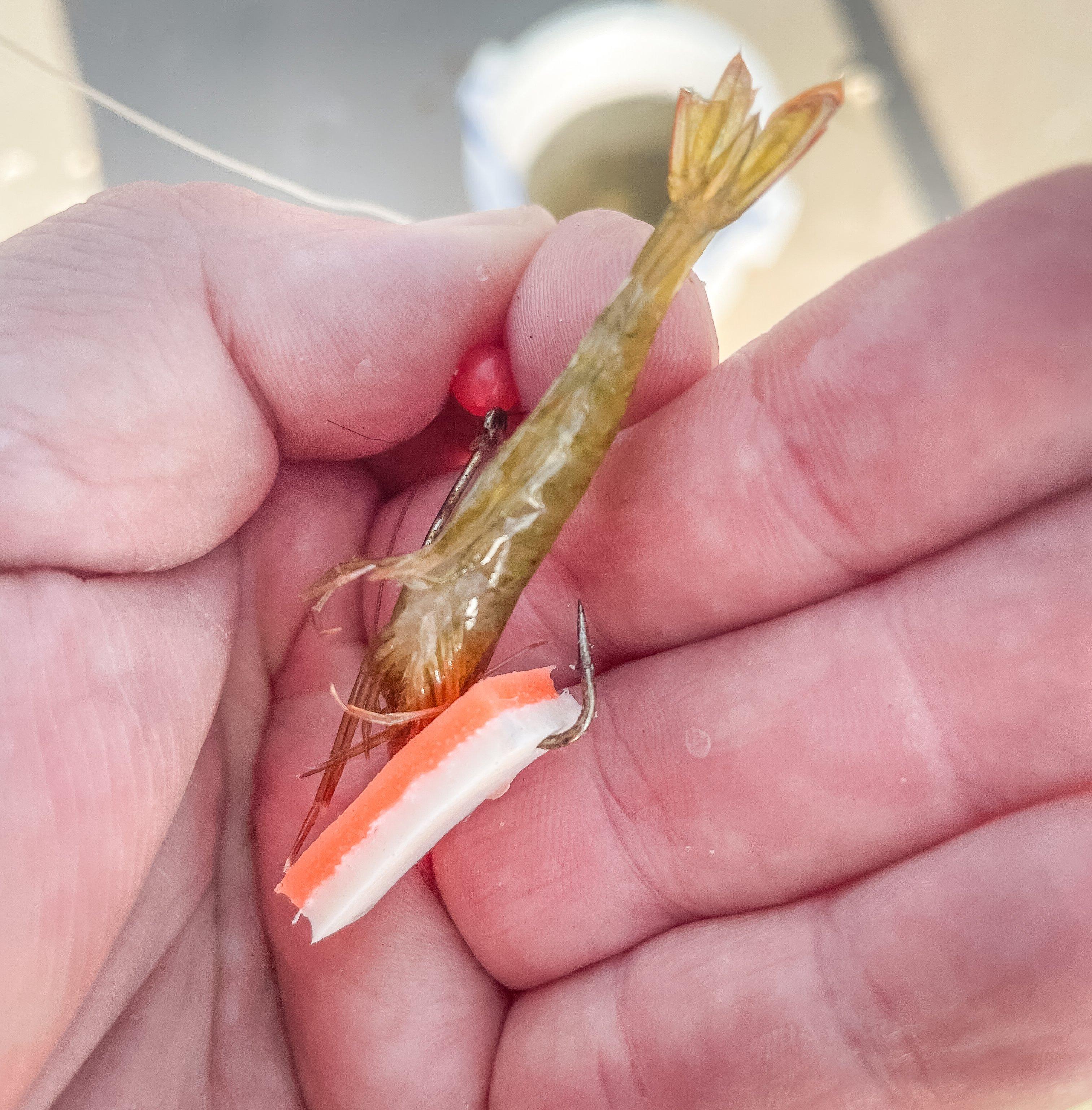
Tip live bait like shrimp with Fishbites or Gulp Strips to add attractive scent and color. Photo by Michael Pendley
Whatever live or cut bait I use, I usually tip my hook with Fishbites or Berkley Gulp Strips. These brightly colored ribbon style baits are packed with natural fish scent fused onto a tough mesh backing. They work well for adding color and scent to your bait setup. In fact, when the spring pompano run hits along the Florida Gulf Coast, many fishermen forego the live or cut bait and fish only with the Fishbites with phenomenal results.
ARTIFICIAL LURES
While bait is often the most effective fishing method, artificial lures can work, too. Popular choices are topwater plugs early and late in the day, rattle style baits, swim baits, and soft plastic jigs.
Norman says his go-to bait is, “a new penny chartreuse tail Gulp shrimp. This is the king of artificial. Use this on a jighead and it will catch anything. If I am targeting flounder, however, I will switch to a white gulp shrimp on a jig. A good rule to follow is: the clearer the water and bottom, the lighter color the bait. If you are jigging for flounder or trout or pompano on a white, candy clear bottom, white or white with chartreuse tail Gulps work very well.”
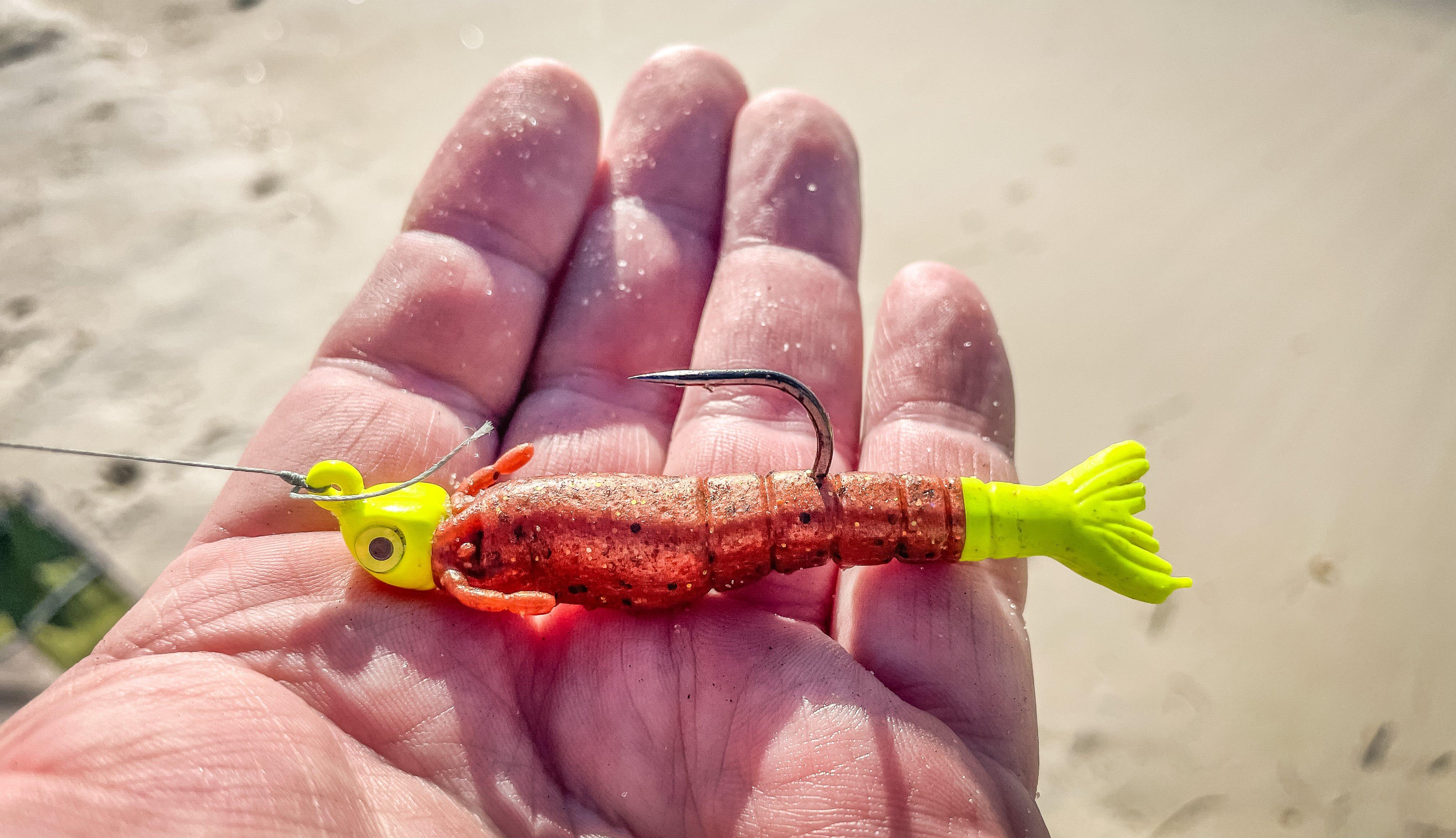
Gulp shrimp on a jighead bounced on bottom will catch a wide variety of surf species. Image by Michael Pendley
WHEN TO FISH
Mornings and evenings are always a good choice, but watch the tides. The best time to surf fish is almost always when the tide is moving. Movement creates current, and fish rely on current to bring them easy meals. Check tide charts of your area. You can often find them posted at local tackle shops or online. They will tell you the predicted times for high tide and low tide. Plan to have your line in the water about 2 to 3 hours before high tide or when tide is on the way out. Moving water often brings larger fish in close in search of bait. If you are targeting large sharks, Norman recommends fishing at night for the most action.
***Don’t Miss: *TIPS FOR PIER FISHING
WHERE TO FISH
For those not familiar, a long stretch of beach may look like there are no distinguishable characteristics that might hold a fish. But look closely. Just like freshwater fish, saltwater species are attracted to cover, depth changes, and differences in bottom contour.
Pay attention, and you’ll often notice a series of sandbars that parallel the bank at increasing distances. Between these sandbars are troughs, and these troughs are fish highways. Try to get your bait centered in the deeper part of the trough. Don’t worry too much about getting way out off the beach; the first trough may be only a few feet out and it often holds the largest numbers of fish patrolling up and down the beach in search of bait. If you are fishing multiple rods, try placing baits at each sequential trough. If one starts to produce more than others, move all your baits to that trough.
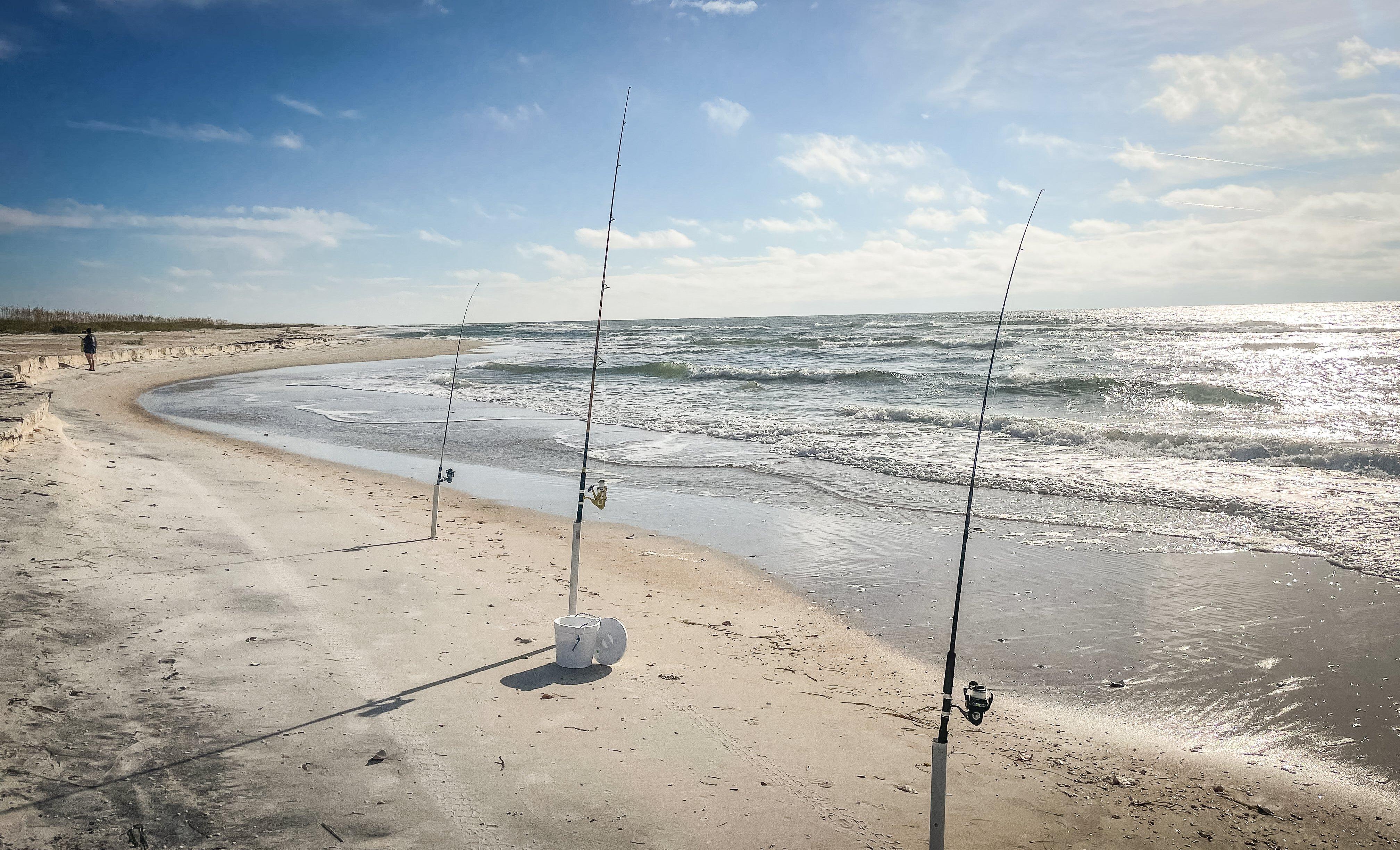
Just like freshwater fish, saltwater fish hold on bottom contour like troughs and points. Photo by Michael Pendley
Other features to watch for are patches of grass, old stump beds, large rocks, and other cover that might shelter bait fish and attract target species. Just like freshwater fish, a channel of deeper water running perpendicular to the troughs away from shore can be a hotspot. Look for points where the shallow sand extends out and drops off quickly. These are also good places to target. If you are fishing brackish bays, freshwater streams flowing into the bay often attract and hold all sorts of gamefish.
While most species tend to hold within easy casting distance of shore, getting your bait beyond the last sandbar is a good way to target sharks, barracuda, and other large predatory species. You can often wade out to the last bar and cast from there, then free spool your line as you wade back to shore. Norman recommends a kayak for taking your bait way out. Simply place your rod in a rod holder with the bail open or the reel in free spool and paddle out to drop your bait before paddling back in. This method works best with two or more fishermen or women so that someone is on shore to watch the rod in case a fish picks up the bait before you can paddle back.
ADDITIONAL GEAR
Other handy gear that will make your saltwater trip more fun and productive include sand spikes, which are tubular rod holders that stick into the sand and hold your rods upright and your reels out of the surf and sand. The simplest ones are made of PVC pipe with an angle cut on one end to help with sand insertion. Other styles feature a section of pipe attached to a metal rod, or bent metal rods designed to grip the reel seats of your rod. You can find these at most tackle shops for a few bucks or make your own at home before you leave.
***Don’t Miss: *DECEASED GREAT WHITE SHARK WASHES UP ON NAVARRE BEACH
When fish are in close, I like to sight fish and cast artificial lures. A pair of polarized sunglasses are a must for seeing into the water. I wear the Swank XL from Tifosi Optics because they fit what has been described more than once as “an unusually large noggin.” They let me see into the water in bright sunlight and allow me to cast in front of cruising fish without spooking them.
I usually pack along a folding chair. Surf fishing often consists of long periods of nothing followed by intense flurries of activity. Being comfortable while you wait means you can stay longer and be there when the fish show up.
Other handy gear includes a fish grabber and long-nose pliers or a hook remover. Many saltwater species have sharp teeth and you don’t want to lip them. A flexible cloth measuring tape will keep you legal if you want to keep fish for dinner and it won’t rust like a metal tape will in the salt air. You can also get stick-on rulers that you can attach to the top of a cooler. A fillet knife for fish cleaning and bait cutting and a towel for wiping your hands will come in handy. If you aren’t familiar with the fish species in the area you are in, check for a fishing regulation book or website with good identification photos and size and possession limits.
This year, when your family brings up a trip to the beach, gear up and go. A few fun days of catching saltwater fish will lead to many outstanding meals and may just change the way you feel about spending time near the ocean. At the very least, it will get you out of a few gift shops.

